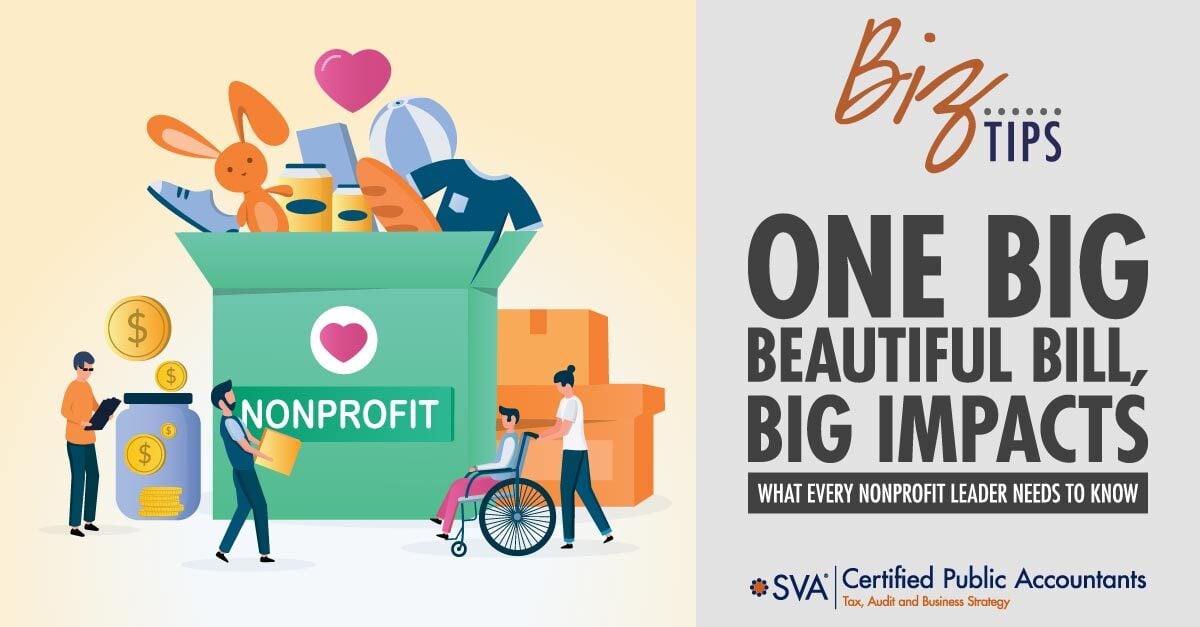| Highlights: |
- Summarizes how the One Big Beautiful Bill Act (OBBBA) reshapes nonprofit fundraising, tax incentives, and donor behavior, especially with a new universal charitable deduction.
- Explains key challenges such as new AGI floors on deductions, limits on major gifts, and evolving federal funding that could pressure traditional revenue streams.
- Offers strategic responses for nonprofit leaders including strengthening reserves, diversifying revenue, and communicating changes to donors to sustain mission delivery.
|
Nonprofit leaders are no strangers to adapting when new legislation reshapes the financial and operational landscape. The One Big Beautiful Bill Act (OBBBA) is no exception. While it brings opportunities for broader giving, it also introduces challenges that organizations must navigate with care.
Below, we’ll walk through the most significant changes, what they mean for nonprofit organizations, and strategies you can use to respond with confidence.
Expanded Universal Charitable Deduction: A Boost for Everyday Donors
One of the most talked-about provisions is the introduction of a universal charitable deduction. Starting in 2026, all taxpayers, including those who don’t itemize, can deduct up to $1,000 per individual or $2,000 per married couple for charitable giving.
For nonprofit organizations, this is a clear opportunity to engage modest donors. Every dollar counts, and now donors who may have given without tax benefits can feel good about both their impact and their tax savings. Messaging to supporters should highlight this change and position it as a way for everyday generosity to go even further.
AGI Floors and Deduction Limits: Headwinds for Major Gifts
On the flip side, the bill introduces new limitations that could dampen enthusiasm for larger gifts. Beginning in 2026, individuals will face a 0.5% floor on charitable contributions, while corporations will only be able to deduct gifts above 1% of their income.
In addition, high-income taxpayers in the top bracket will see their itemized deduction benefit capped at 35% rather than 37%.
The result? Larger donors may feel less incentivized to give, and nonprofit organizations reliant on major gifts could face funding pressures. Organizations should prepare by strengthening donor relationships, encouraging multi-year pledges, and working closely with financial advisors to help donors structure their giving in tax-smart ways.
Scholarship Tax Credits: A Mixed Bag
Education-focused nonprofits may benefit from a new federal tax credit for donations to Scholarship Granting Organizations (SGOs). This opens the door to expanding scholarship programs and deepening ties with families. However, it could also create unintended competition, as donations shift toward education-focused initiatives and away from other causes.
Education nonprofit organizations should start preparing targeted campaigns to highlight the direct impact of scholarships. Meanwhile, organizations outside of education must double down on telling their story: why their work matters, and why ongoing support is vital.
Executive Compensation: Renewed Scrutiny
The OBBBA reinstates a 21% excise tax on nonprofit executive compensation exceeding $1 million, extending to the top five earners within an organization. While this will mostly affect large hospitals, universities, and national organizations, it could spark broader donor scrutiny around nonprofit salaries.
Even mid-sized organizations should be prepared to answer questions about compensation practices. Boards should review policies, benchmark salaries against industry standards, and clearly document decision-making. Transparent communication helps maintain donor trust, regardless of whether your leadership team is near the million-dollar threshold.
Federal Spending Cuts and Grant Freezes: Shifting the Burden
Perhaps the most pressing challenge for many nonprofit organizations will come from cuts to federal safety net programs and potential freezes on federal grants. Reductions in Medicaid, SNAP, housing assistance, and other programs may increase demand for nonprofit services just as government dollars become harder to access.
This creates financial strain and possible service disruptions. To stay resilient, nonprofit organizations should:
| Diversity revenue streams |
to avoid overreliance on federal funds. |
| Build reserves |
and secure lines of credit for cash flow stability. |
| Educate donors |
on how policy changes are affecting your mission, inviting them to step in where government support has pulled back. |
| Collaborate with peers |
sharing resources or partnering on services to stretch limited budgets. |
Legal and Political Risks: Heightened Scrutiny
Nonprofit organizations engaged in advocacy, DEI work, reproductive health, immigrant rights, or LGBTQ+ support may face increased legal and political risks. While not written directly into the tax code, recent executive actions point to greater oversight and possible funding challenges for advocacy-focused organizations.
The best defense is preparation: document your activities, keep communications nonpartisan, and educate both staff and board members on compliance guidelines.
Transparency and collaboration with other nonprofit organizations can help protect your mission while maintaining donor confidence.
Navigating the New Landscape
The OBBBA represents a new era for nonprofit fundraising and operations. On one hand, the expanded universal deduction will likely inspire a wave of small-dollar gifts. On the other, new restrictions could curb large-scale giving and create turbulence in government funding.
For nonprofit leaders, the path forward is about adaptation and communication:
| Tailor fundraising strategies |
for both modest and major donors. |
| Build messaging around tax season |
reminding supporters of the benefits available. |
| Stay proactive |
by strengthening reserves, exploring new revenue streams, and keeping donors informed about the challenges you face. |
The nonprofit sector has weathered sweeping changes before, from the Tax Cuts and Jobs Act to pandemic-era relief programs. With foresight, creativity, and strong partnerships, organizations can once again adjust to this evolving environment and continue serving their communities.
© 2025 SVA Certified Public Accountants

